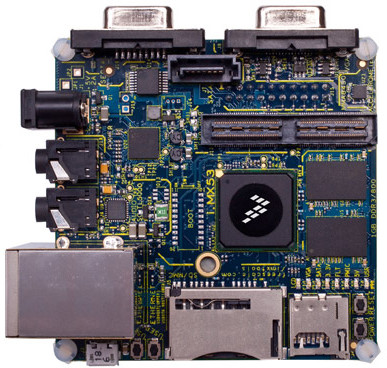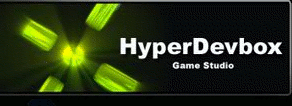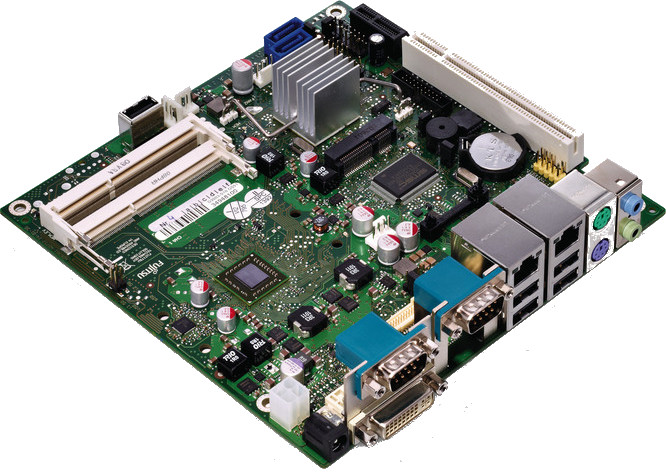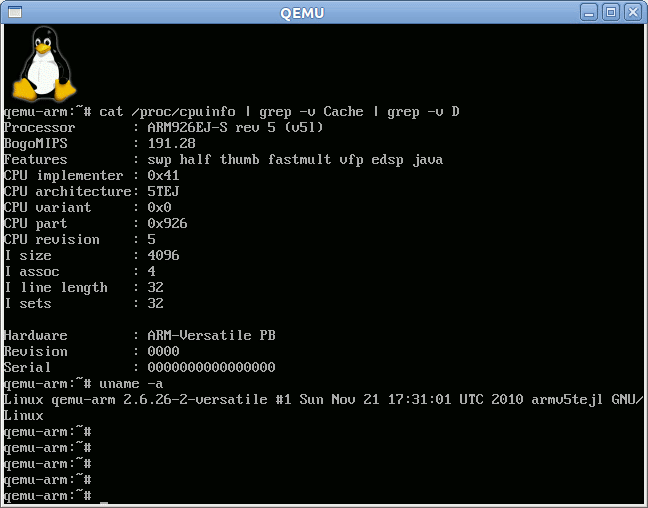Possibly inspired by Texas Instruments low cost Beagleboard (OMAP 3 – 129 USD) and Pandaboard (OMAP4 – 179 USD) and the large following in the development community, Freescale announced its own “Quick Start Development Board” based on i.MX53 for a cost of 149 USD. i.MX53 QSD Board Hardware Description Listed Hardware Features of the i.MX53 Quick Start Development Board: Processor i.MX53 1 GHz ARM Cortex-A8 Processor Power management IC 1 GB DDR3 memory Display LVDS connector VGA connector Parallel LCD add-on card (via expansion connector) HDMI add-on card (via expansion connector) Audio SPDIF output via HDMI add-on card Freescale SGTL5000 audio codec Microphone jack Headphone jack Expansion Connector Enables parallel LCD or HDMI output Camera CSI port signals I2C, SSI, SPI signals Connectivity Full-size SD/MMC card slot microSD card slot 7-pin SATA data connector 10/100 Base-T Ethernet port Two High-Speed USB host ports Micro USB device port Debug JTAG connector […]
Databases for Linux Embedded Systems: Berkeley DB and SQLite
Embedded systems often need to use database to store contact information, EPG data and more. Many Linux systems use MySQL, however such a large database management system may not always be appropriate for embedded systems. Hence, there are lightweight database management systems implementation that are especially suited to embedded systems by their binary footprint, memory footprint and CPU requirements. If you want to develop in C in Linux and your requirement is to have no (or little) license to pay in your application, you could consider Oracle Berkeley DB or SQLite among others. Oracle Berkeley DB (previously Sleepycat Berkeley DB) is described as follows: Berkeley DB enables the development of custom data management solutions, without the overhead traditionally associated with such custom projects. Berkeley DB provides a collection of well-proven building-block technologies that can be configured to address any application need from the hand-held device to the datacenter, from a […]
Android C/C++ development with Android Native SDK
HyperDevBox is a Japanese based software development company, developing games for Android. They are presenting their new Android game called “Spectral Souls”, the first tactical RPG game for Android. The interesting part is that this Android gamewas not developped with Java, but only using C/C++ programming with Android Native SDK (NDK) (Currently revision 5). Using the NDK means you’ll have to adapt your software to several hardware platform contrary to java development. They now only support Qualcomm and PowerVR GPU for now, and they are working on supporting NVidia Tegra platform and other upcoming GPU. The advantage of native code is a potential performance improvement and code re-use if you have already applications developed in C/C++, the inconvenience is that more work is need to support different hardware. Currently the NDK is only available for ARM platforms (ARMv5TE andARMv7-A), future releases will support x86 instructions. The video below is an […]
Low Cost Android Tablets: Archos Arnova 8 and Arnova 10
Archos – a leader in low cost android tablet with its Archos Gen8 Series (Archos 28/32/48/70/101) – has just released the Arnova Series with the Archos Arnova 8 (149 USD), an 8″ inch Android 2.1 tablet and Archos Arnova A10HT (199 USD), a 10.1″ Android 2.1 tablet. Currently those 2 tablets are based on Rockchip ARM9 RK2818 @ 600 Mhz and use a resistive touchscreen, but in the next few months, they’ll release version with Rockchip RK2918 @ 1GHz (Cortez A8 based), a capacitive touchscreen and Android 2.3 (Gingerbread) for the same price. The firmware of those tablets is apparently not directly supported by Archos, but is developed by a subsidiary in Hong Kong called Arnova (hence the name). Usually the IT (Internet Tablet) series are developed and supported by Archos (better support) and HT (Home Tablet) developed and supported by third parties. Have a look at Charbax’s video of the […]
Linaro Development Board “Snowball” by ST Ericsson
ST Ericsson unveiled a development board based on Nova A9500 (dual ARM Cortex A9 processor and MALI 400 GPU) at MWC 2011 called Snowball (or SKY-S9500-ULP-CXX) for the embedded Linux community and professional developers. This board was designed by CALAO Systems and can be pre-ordered on their website for 200 USD (SKY-S9500-ULP-C11 / Software Development Kit – SDK) or 300 USD (SKY-S9500-ULP-C01 / Production development Kit – PDK). The difference between the SDK and PDK is that the former has no expansion connectors, no battery backup for RTC and only support serial over USB port (for Linux console). First, some pictures with description of the snowball development board. The full documentations for Snowball development board can be found in Calao Systems File Repository, where you’ll get the bottom and top assembly diagrams for both C01 and C11, the major components datasheet, documentation and some photos. The specifications of the boards: – […]
Samsung at MWC 2011: Galaxy Tab 10.1 and Galaxy S 2
Samsung will showcase two highly expected products at Mobile World Congress 2011, in Barcelona: The Galaxy S II smartphone with a 4.3″ Super AMOLED Plus display and dual-core processor and the new Galaxy Tab 10.1 (aka Galaxy Tab 2) with a 10.1″ display (1280×800) running Android 3.0 (Honeycomb). Samsung GALAXY S II Product Specifications are as follows: Network GSM 850/900/1800/1900 HSPA+ 21 850/900/1900/2100 OS Android 2.3 Gingerbread Display 4.27” WVGA (480×800) Super AMOLED Plus Processor ( BB& AP ) 1 GHz Dual Core Application Processor Camera Main(Rear): 8.0-Mega Pixel Camera AF with LED Flash Front: 2.0-Mega Pixel Camera Single Shot, Beauty Shot, , Panorama Shot, Smile Shot, Action Shot, Cartoon Shot Video Codec : MPEG4/ H.264/ H.263/ DivX VC-1 Playback : FULL HD(1080p)@30fps Recording : FULL HD(1080p)@30fps Audio MP3, AAC, AAC+, eACC+ 3.5mm Ear Jack & Speaker, Stereo FM Radio with RDS, Voice Recorder Hub Social Hub – Integrated Contacts, […]
AMD Embedded G-Series mini-PC, motherboard and thin client
AMD announced its embedded processor G-Series at CES 2011. Here are some products that will be soon available based on this platform. Futjisu Mini-ITX mainboards – models D3003-S1 and D3003-S2 The D3003-S1 motherboard will feature an AMD Single-Core T44R (1.2GHz/9W) and the D3003-S2 an AMD Dual-Core T56N (1.6GHz/18W). Both models will have an onboard ATI graphics card with VGA, DVI, LVDS (D3003-S1 only) and diplayport (D3003-S2 only) outputs, HD Audio, dual GbE LAN, serial ATA III RAID, mSATA socket support, USB 2.0, 8 Bit GPIO connector and be designed for fanless operation. Mass production of the boards will start in April 2011. Check the preliminary specifications for details. CompuLab’s fit-PC3 mini-PC Compulab already manufactures the fit-PC2 and fit-PC2i based on the Intel Atom platforms running Linux, Windows XP and Windows 7. The Israel-based company will embed AMD Embedded G-Series processor in its latest fit-PC3 mini-PC. This “miniature fanless industrial PC” […]
Emulate an ARM Plaform with QEMU on Ubuntu 10.10
When developing software for embedded systems, you may need to support multiple architectures such as arm, mips, x86, powerpc, alpha etc.. but you may not have the hardware required on hand to test them. This is where QEMU – a processor emulator – comes to the rescue. In a way, QEMU is similar to VirtualBox, VMWare or Citrix Xendeskop except it can support multiple architectures. I’ll show how to run Debian Lenny ARMEL in QEMU on a computer running Ubuntu 10.10 (aka Ubuntu Maverick Meerkat). QEMU (Qemu-kvm) Installation First install qemu-kvm and qemu-kvm-extras (the latter contains qemu-system-arm): sudo apt-get install qemu-kvm qemu-kvm-extras Let’s check qemu version: jaufranc@CNX-TOWER:~/edev$ qemu –version QEMU PC emulator version 0.12.5 (qemu-kvm-0.12.5), Copyright (c) 2003-2008 Fabrice Bellard Debian ARM Installation in QEMU Create a directory to store the required files for the emulator and download the Debian Lenny ARMEL kernel (vmlinuz) and debian installer rootfs (initrd.gz): mkdir […]









